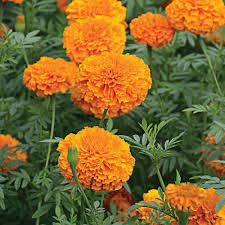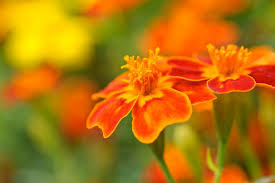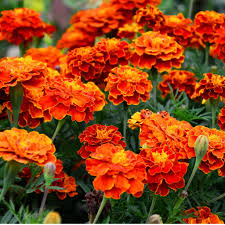Marigolds are a vibrant and versatile flower, especially valued for their fall color. A gardening tip shared by my friend Lois has stuck with me over the years: sow marigold seeds in late spring, once the soil is warm. Place them in a convenient nursery bed where they can be easily weeded and watered. Once they grow to about 4 inches tall, transplant them to their final spots. Due to their late start, marigolds will bloom in late summer and continue until the first frost, providing bold, long-lasting color, often outperforming chrysanthemums.
Types of Marigolds
Native to the Americas, marigolds thrive in warm conditions. There are several species, each offering unique attributes that enhance the garden in various ways.
1. Large-Flowered Marigolds (Tagetes erecta)
These tall, upright marigolds can grow up to 24 inches and are known for their large, ruffled blooms in vibrant yellow and orange shades. Sometimes called African or American marigolds, they might look a bit bulky in summer, but in the fall, their bold colors become a striking feature. These marigolds are also beneficial for eye health, as their petals contain lutein and zeaxanthin—two important phytochemicals. Dried marigold petals can be used in smoothies, teas, or even as a supplement for poultry feed, adding extra health benefits to your diet.

2. French Marigolds (Tagetes patula)
French marigolds are smaller, growing to about 18 inches tall, and are often hybridized between large-flowered marigolds and signet marigolds. They are known for their musky fragrance and vibrant blooms, making them ideal for low-maintenance, colorful displays in commercial landscapes. Additionally, French marigolds have a unique benefit: they can help control soil-borne root-knot nematodes, which are a common pest in warm climates. By planting these marigolds as cover crops, you can naturally reduce the nematode population in your soil.
3. Signet Marigolds (Tagetes tenuifolia)
These marigolds stand out for their airy, delicate appearance. With thin stems that tend to cascade, they are covered in smaller, charming flowers in shades of yellow, orange, and mahogany. Signet marigolds release a citrusy fragrance when crushed, and their petals have a sweet, floral taste, making them a great addition to salads. Known as “gem marigolds,” they are perfect for container gardening, and varieties like ‘Lemon Gem’ and ‘Orange Gem’ remain popular. These marigolds are also easy to grow from saved seeds, making them an excellent choice for home gardeners.

Cultural and Culinary Significance
Marigolds have more than just aesthetic value. In Mexico, marigold blossoms are commonly used to decorate graves, symbolizing remembrance and celebration of life. In India, marigolds are integral to religious and cultural ceremonies, where their bright orange and yellow blooms are used for offerings and decorations. While my fall marigolds don’t serve a specific cultural purpose, their stunning colors provide a rich, seasonal beauty in my garden.

Conclusion
Marigolds are a gardener’s best friend, offering vibrant color, pest control, and even health benefits. Whether you’re planting them for their ornamental beauty, their ability to combat nematodes, or their use in culinary creations, marigolds are easy to grow and provide long-lasting rewards. As the season transitions, let marigolds fill your garden with brilliant hues, making the most of their ability to thrive well into the fall.
